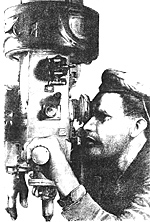
PETER HANSEN (251-LIFE-1987) spent time working for the ABWEHR (the German Secret Service) during WW II and he has information that is known to a mere handful of people. He gives this secret information especially to SHARKHUNTERS. Here we continue with PETER’s observations and comments on the relationship between German and Japanese during World War II.
One ought to mention that often Allied POW’s were assigned by the Japanese to work on offloading ships and building port facilities and similar jobs, most of them Australians and English fellows. Frequently the U-boat crews fed them and sneaked smokes, drinks and meals to them and on several occasions, got into severe fights with the Japanese watch personnel and directing officers, especially when these Allied POW’s were mistreated in the brutal hot sun and kept without fluids and punished for singing or not working fast enough, while the Japanese just watched them and yelled at them and threatened them.
EDITOR NOTE - there is one such incident in which a German U-boat crewman was relaxing and having a smoke on the dock in a Japanese held port. The Japanese guard came up behind him and, thinking he was an Allied POW loafing, hit him and yelled at him to get back to work. The German U-boat crewman just picked up the Japanese guard and tossed him into the ocean.
After capitulation in May 1945 the crews still in the Far East likewise became POW’s of the Japanese and because they traded with the Malays and Chinese, these in turn now also helped with Allied prisoners likewise, in addition to their German friends which were in some cases, of long standing. After August of 1945, the Allied POW’s often were material in making sure these German Navy people who had helped them, were treated more decently than the ‘Base Wallahs’ were inclined to do, who were often second line draftees without front line experience but pumped full of misinformation and propaganda.
You have already brought out some of the facts with respect to the sinking of U-859 under Johann Jebsen, Class of 1935. He was formerly captain of U-565 before becoming captain of U-859 though again, not the whole story. The British submarine HMS TRENCHANT was commanded by Arthur R. Hazlett, who later became a Vice Admiral, when it torpedoed U-859 on 23 September 1944 already in shallow waters proceeding into the shipping channel to Penang.
 U-861 under Jürgen Oesten (1681-LIFE-1990) (at right)was supposed to enter Penang at almost the same time, but the coded messages had been cracked by the British ULTRA system where a regional branch operated out of Tricomalee on the then island of Ceylon, now called Sri Lanka and Commander Hazlet had been specifically ordered and directed to be off the Penang channel in time to intercept and torpedo one or both of these U-boats.
U-861 under Jürgen Oesten (1681-LIFE-1990) (at right)was supposed to enter Penang at almost the same time, but the coded messages had been cracked by the British ULTRA system where a regional branch operated out of Tricomalee on the then island of Ceylon, now called Sri Lanka and Commander Hazlet had been specifically ordered and directed to be off the Penang channel in time to intercept and torpedo one or both of these U-boats.
I have never been able to understand the attitude of Jan Jebsen, whom I happened to know as a level-headed chap, to order an officer’s discussion traveling on the surface of all things, in a mined channel where the Obersteuermann had been assigned to bridge duty so that the officers could participate in this inane pow-wow instead of making sure only the absolutely essential engineroom people were on duty with the entire rest of the crew on deck with swimvests (life jackets) and manning the anti-aircraft guns.
While attending this meeting, the II.W.O. Horst Klatt (4234-1995) suddenly has to go to the head. Jebsen is annoyed, but permits him to take off to the toilet. Klatt had barely closed the door when the torpedo hit the officer’s quarters and killed everybody in that section. The head door flies open and Klatt gets tossed outside, and consequently becomes the only officer to survive this sinking in in 80 meters waterdepth (about 260 feet) by managing to escape with rescue equipment together with about twenty other crew members. The submarine HMS TRENCHANT picks Klatt up and also seven other survivors, despite Japanese patrol boats being in sight, and takes them back to Admiral Lord Mountbatton’s headquarters on Ceylon. The Japanese patrol boats pick up some more of the others floating about in shark infested waters and another eight of these also survive to reach Penang Harbor.
U-859 was the only snorkel equipped U-boat that operated in the Far East. It departed Kiel Harbor on 4 April 1944, traveling with a brief refueling stop in Christiansand, Norway before traveling into the South Atlantic. After the usual technical and operational difficulties with the snorkel, after insufficient training time in the Baltic, the first steamer is sighted on 26 April and sunk. It was the Panamanian-flagged motorvessel COLIN with 6,255 tons. Cape town, South Africa is reached at the end of June without problems from aircraft or aircraft carrier hunter-killer groups in the South Atlantic. No traffic is encountered coming out of or entering the various South African ports, but ULTRA has cracked the July 1st position report of U-859 and she is constantly found and attacked by a CATALINA flying boat aircraft on July 8th and bombed. After three repeated attacks, with several wounded crewmembers due to machine gunning from the CATALINA, U-859 manages to five after outmaneuvering all bombs and depth charges and thereafter snorkeling for 130 hours to change positions, make repairs of damages suffered, and to get away!
No shipping is found either off the East African coasts or in the Mauririus Channel, thus U-859 proceeds into the Gulf of Aden. On 28 August 1944 U-859 sinks the American Liberty Ship JOHN BARRY loaded with tons and tons of silver and precious coins.
EDITOR NOTE - a few years ago, some of our Members formed a group to salvage this treasure and did indeed successfully salvage most or all of the millions of freshly-minted silver Saudi Riyals but they were not able to raise any of the hundreds of tons of silver bars reportedly aboard JOHN BARRY. They could not even find a trace of these silver bars, which raises some questions such as: why were these coins minted in the USA and shipped to Saudi Arabia? Where was the cargo of silver bars headed and why? And the big question - did the hundreds of tons of silver bars actually get loaded aboard JOHN BARRY or were they quietly moved elsewhere in the American port and paperwork falsified? It would not be the first time…
On 1 September 1944, U-859 sinks the British steamer TROILUS of 7,422 tons. Because U-861 is delayed in arriving, Jebsen is ordered to enter Penang alone and without escorts rather than hanging around waiting in shallow waters with difficult currents, and gets the chop as a consequence.
It is remarkable that Lt. (Ing.) Horst Klatt (4234-1995) survived the second sinking of a U-boat when he reaches the surface and is rescued because he was also aboard U-612 where Herbert A. Werner (18-C-1983) was I.W.O. when U-612 was rammed by U-444 under Oblt. Albert Langfeld in the Bay of Danzig while exercising and training and sunk, becoming a total loss to be scrapped after it was lifted to the surface by special heavy duty floating cranes. How is that for dumb luck?
This is great insight into the specifics of the war - not only the dry dates of battle etc., but what the individual people were doing, how that affected their participation in the war and the outcome of some actions as well. More of PETER’s memories of the War at Sea in KTB #152 next month.
Back to KTB # 151 Table of Contents
Back to KTB List of Issues
Back to MagWeb Master Magazine List
© Copyright 2001 by Harry Cooper, Sharkhunters International, Inc.
This article appears in MagWeb (Magazine Web) on the Internet World Wide Web. Other military history articles articles are available at http://www.magweb.com
Join Sharkhunters International, Inc.: PO Box 1539, Hernando, FL 34442, ph: 352-637-2917, fax: 352-637-6289, www.sharkhunters.com
